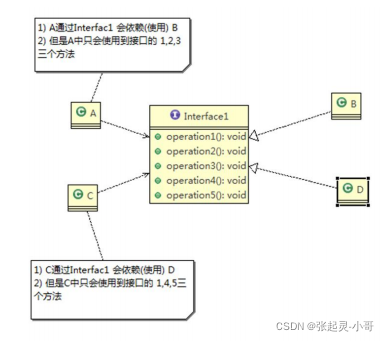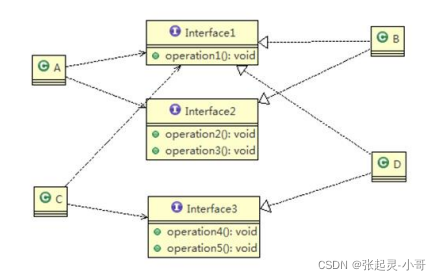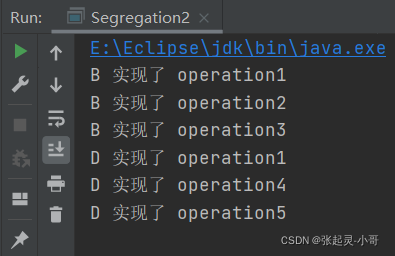您好,登錄后才能下訂單哦!
您好,登錄后才能下訂單哦!
小編給大家分享一下Java中接口隔離原則是什么,相信大部分人都還不怎么了解,因此分享這篇文章給大家參考一下,希望大家閱讀完這篇文章后大有收獲,下面讓我們一起去了解一下吧!
客戶端不應該依賴它不需要的接口,即一個類對另一個類的依賴應該建立在最小的接口范圍上。

上面這張圖呢,就違反了接口隔離原則。它對應的代碼如下:????????????
package com.szh.principle.segregation;
/**
*
*/
interface Interface1 {
void operation1();
void operation2();
void operation3();
void operation4();
void operation5();
}
class B implements Interface1 {
public void operation1() {
System.out.println("B 實現了 operation1");
}
public void operation2() {
System.out.println("B 實現了 operation2");
}
public void operation3() {
System.out.println("B 實現了 operation3");
}
public void operation4() {
System.out.println("B 實現了 operation4");
}
public void operation5() {
System.out.println("B 實現了 operation5");
}
}
class D implements Interface1 {
public void operation1() {
System.out.println("D 實現了 operation1");
}
public void operation2() {
System.out.println("D 實現了 operation2");
}
public void operation3() {
System.out.println("D 實現了 operation3");
}
public void operation4() {
System.out.println("D 實現了 operation4");
}
public void operation5() {
System.out.println("D 實現了 operation5");
}
}
class A { //A 類通過接口Interface1 依賴(使用) B類,但是只會用到1,2,3方法
public void depend1(Interface1 i) {
i.operation1();
}
public void depend2(Interface1 i) {
i.operation2();
}
public void depend3(Interface1 i) {
i.operation3();
}
}
class C { //C 類通過接口Interface1 依賴(使用) D類,但是只會用到1,4,5方法
public void depend1(Interface1 i) {
i.operation1();
}
public void depend4(Interface1 i) {
i.operation4();
}
public void depend5(Interface1 i) {
i.operation5();
}
}
public class Segregation1 {
public static void main(String[] args) {
A a = new A();
a.depend1(new B()); // A類通過接口去依賴B類
a.depend2(new B());
a.depend3(new B());
C c = new C();
c.depend1(new D()); // C類通過接口去依賴(使用)D類
c.depend4(new D());
c.depend5(new D());
}
}代碼雖然很長,但是不難理解。A類依賴了B類,但是只會用到頂級接口中的1、2、3這三個方法;而C類依賴了D類,但是只會用到頂級接口中的1、4、5這三個方法,也就是說在A和B這兩個類的層面上而言,和頂級接口中的4、5兩個方法是沒什么關聯的,那么B類在實現頂級接口的時候就沒必要重寫4、5這兩個方法了。但是這里有一個問題就是頂級接口中包括了1到5這五個方法,你如果實現這個接口就必須重寫這五個方法,那么我們就可以考慮將頂級接口拆分成多個接口,需要用到哪個就實現哪個,這也就是所謂的接口隔離了。

經過上面的一番敘述,我們可以將代碼改寫成下面的形式。
即將頂級接口拆分成3個小接口,B、D兩個類根據實際情況該實現哪個接口就實現哪個接口(因為這五個方法已經被分開了)。
package com.szh.principle.segregation.improve;
/**
*
*/
interface Interface1 {
void operation1();
}
interface Interface2 {
void operation2();
void operation3();
}
interface Interface3 {
void operation4();
void operation5();
}
class B implements Interface1, Interface2 {
public void operation1() {
System.out.println("B 實現了 operation1");
}
public void operation2() {
System.out.println("B 實現了 operation2");
}
public void operation3() {
System.out.println("B 實現了 operation3");
}
}
class D implements Interface1, Interface3 {
public void operation1() {
System.out.println("D 實現了 operation1");
}
public void operation4() {
System.out.println("D 實現了 operation4");
}
public void operation5() {
System.out.println("D 實現了 operation5");
}
}
class A { // A 類通過接口Interface1,Interface2 依賴(使用) B類,但是只會用到1,2,3方法
public void depend1(Interface1 i) {
i.operation1();
}
public void depend2(Interface2 i) {
i.operation2();
}
public void depend3(Interface2 i) {
i.operation3();
}
}
class C { // C 類通過接口Interface1,Interface3 依賴(使用) D類,但是只會用到1,4,5方法
public void depend1(Interface1 i) {
i.operation1();
}
public void depend4(Interface3 i) {
i.operation4();
}
public void depend5(Interface3 i) {
i.operation5();
}
}
public class Segregation2 {
public static void main(String[] args) {
A a = new A();
a.depend1(new B()); // A類通過接口去依賴B類
a.depend2(new B());
a.depend3(new B());
C c = new C();
c.depend1(new D()); // C類通過接口去依賴(使用)D類
c.depend4(new D());
c.depend5(new D());
}
}
類A通過接口Interface1依賴類B,類C通過接口Interfacel依賴類D,如果接口Interface1對于類A和類C來說不是最小接口,那么類B和類D必須去實現他們不需要的方法。
將接口Interface1拆分為獨立的幾個接口,類A和類C分別與他們需要的接口建立依賴關系。也就是采用接口隔離原則。
以上是“Java中接口隔離原則是什么”這篇文章的所有內容,感謝各位的閱讀!相信大家都有了一定的了解,希望分享的內容對大家有所幫助,如果還想學習更多知識,歡迎關注億速云行業資訊頻道!
免責聲明:本站發布的內容(圖片、視頻和文字)以原創、轉載和分享為主,文章觀點不代表本網站立場,如果涉及侵權請聯系站長郵箱:is@yisu.com進行舉報,并提供相關證據,一經查實,將立刻刪除涉嫌侵權內容。